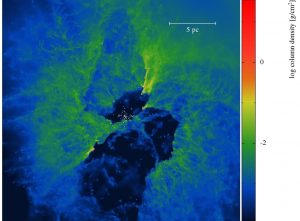Galaxies and their evolution
The galaxies group in the School of Physics and Astronomy comprises around 20 researchers, including teaching and research staff, postdocs, and PhD students. Our Research Interests include a wide variety of topics, from the deep secrets of star formation and small-scale processes taking place in Active Galactic Nuclei (AGN), to how galaxies form and evolve and the nature of dark matter. To address these problems we make use of both numerical simulations such as Monte Carlo Radiative Transfer and Smooth Particle Hydrodynamics, and observations at many wavelengths from the UV to the radio.
Our expertise and wide variety of research interests are complemented by the involvement of our group members in a number of international collaborations and observational surveys at all scales, such as CALIFA, GAMA, CANDELS, VANDELS, MaNGA and eBOSS. Upcoming surveys and missions include DESI, JWST, LSST and Euclid.
Stellar populations
Vivienne Wild, Rita Tojeiro
Knowledge of the star formation histories of galaxies is required in order to accurately determine their physical properties, such as stellar mass, and to help us understand the physical processes that cause galaxies to evolve over time. Examples of past projects include the accurate determination of star formation histories from spectra (e.g. with the VESPA code) and identification and characterisation of rare objects such as post-starburst galaxies.
Interstellar medium
Kenny Wood, Ian Bonnell
The interstellar medium or ISM is the vast reservoir of gas and dust that fills the galaxy and, as it coalesces, provides material for the next round of star formation. The properties of the ISM are determined by physical processes over a range of scales. St Andrews researchers have show how the densest phases of the ISM, star forming clouds, are born in the interactions of gas with a galaxy’s spiral arms. Stars themselves produce feedback such as radiation pressure, stellar winds, and supernovae events, which influence the physical conditions (density, temperature, chemistry, metallicity) in nearby clouds. Magnetohydrodynamic and radiative transfer simulations show how this can affect later star formation and alter the structure of the host galaxy over kiloparsec scales.

Shown is a simulation of a supernova detonation taking place within a star forming cloud. The supernova originated from a star of almost 96 solar masses located in a cluster forming within a dense filament of gas. This snapshot shows how, 86,000 years after the explosion, the cloud has been torn apart and formed low density escape channels. As a result, the stars in the main cluster, seen as the white points near the centre, are no longer accreting, while a nearby cluster to the upper right has remained embedded. Comparison with similar simulations in which earlier feedback in the form of ionization and stellar winds shows that in these cases the supernova’s effect may be greatly reduced.
Galaxy dynamics
Anne-Marie Weijmans, Vivienne Wild, Ian Bonnell
The dynamics of stars and gas in galaxies tells us about how they formed and evolved with time. With integral field surveys such as CALIFA and MaNGA, the kinematics of both the stars and gas in large numbers of galaxies can now be studied. Complementary to this are hydrodynamic simulations, that help us to interpret the observations. We post-process simulations to make mock observations, to compare directly with our survey datasets.
Active Galactic Nuclei
Keith Horne, Vivienne Wild
Many galaxies harbour active nuclei (AGN), where matter accreting onto a super massive black hole emits significant amounts of radiation. The group has a long standing interest in the technique of reverberation mapping, which beats resolution limitations of conventional observations to allow us to “see” into the central engine of the AGN. The group also works on the links between AGN and their host galaxies, to understand the impact of AGN on galaxy evolution.
Galaxies Group Meetings
The Galaxies Group hosts lunch meetings every Thursday from 13:00 to 14:00 in room 301.
If you have any question about the Galaxies Group Meetings, please contact Carl Roberts (cr214).
Galaxy lunch will usually be in the format of a journal club, so everyone is encouraged to bring a paper they would like to summarise to the rest of the group. If you are looking for interesting papers to present check out our private CiteULike and Benty Fields groups where we post the papers we want to discuss.
Other formats we have:
• Review article: presented in detail by our first-year PhD students.
• Plots: PhD students in particular are encouraged to bring a plot they have recently made. Staff and postdocs will do their best to provide useful feedback and comments on these plots.
• Talks: short talks to share some results or to practise for a conference.
• Conference reviews: if a group member has recently attended a conference/workshop and there are some interesting results they want to summarize to the group, galaxies lunch is the ideal place to do it.
